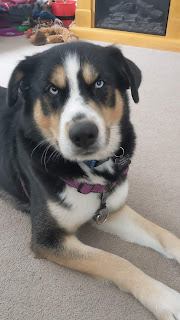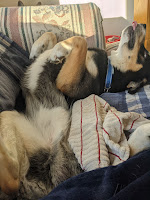How do you choose which goals to build into your training plan?
It sounds simple, but it can be difficult if you try to bite off more then you can chew. I find that if you are new to planning people either don't include enough info in their plan or they include too much info so they never look at the plan again because it seems too hard. I'm going to break it down into simple categories to help you decide what is most important to you.
The 3 Month Goals
This is my start and sometimes my finish to my training plans. If you struggle with planning and you can only focus on this part of the plan, then it's the perfect place to start. And often this is the only part of my plan that I give to clients. While I might be thinking bigger picture, I want to make sure not overwhelm them with too much too fast.Ideally I want a 3 Month Plan that tackles 2-4 of the struggles a person is facing with their dog. Common struggles might include negative behaviors such as barking, puppy nipping, counter surfing, or really any behavior that dogs often do naturally but really don't fit well in the human world. Once I have selected my trouble behaviors I'm going to create a 3-4 step approach to solve that trouble area. For example, if it's a puppy with a habit of jumping on people my suggestions might look like this:
- Teach puppy an alternate behavior that is incompatible with jumping on their person. This could be going to a place/mat, sitting and waiting for attention, or centering under the person's legs. This is going to focus on teaching the dog what to do with their main person.
- Teach puppy what to do with greeting strangers or other friends & family members that are in your house, yard, in the community, etc.
- Create a management plan to help your puppy be successful during the training period; use a leash, baby gates, etc to help puppy remain calmer without letting excitement get out of control.
Concept Training
If I want to push my plan a little bit further, I will develop 1 or 2 concept based goals. I might include a little bit of this in my simple 3 month plan, but if I want to tackle larger concepts such as Cooperative Care, Settling Around Distractions, Intelligent Disobedience or other lifestyle goals vs specific behaviors this is where I focus on that. These are generally things that will never been trained to a level where they will be completely learned because there are always ways to adapt them to be better and stronger. Use scent training for example, I might focus on scent training a specific scent as a short term 3 month goal but I would put games that develop thinking skills around scent in the concept goals section. Find It is a game that I play with all dogs, but since scent is so important for Migraine Alert Service Dog I want to really create a smart thinker when it comes to scents. By starting small with easy Find It games and slowly increasing the difficulty my dogs learn to use their nose and brain together to locate things they are hunting for. Now I might not add the scent training in every plan I create for my dog, but I will never stop pushing the envelope to make it harder and harder as my dog develops better skills. I'm going to include the scent training concept on any plan where I feel that my dog needs more refreshing or practice with a particular part of the concept.
When it comes to concept training, you want to think of things that you will always reinforce in some fashion for the rest of your dog's lifetime. Azul will always receive reinforcement for a migraine alert, a perfect recall, and awesome settles in public. That reinforcement might change over time and most generally will change from day to day, but reinforcement will always be available for correctly applying the bigger concepts. This is really all about teaching the dog to make choices in life and that choices matter; something happens around your dog, their reaction matters, reinforcement happens for reactions you want repeated.
Long term goals
This is where I'm going to tackle some of the more challenging behaviors that I want to teach my dog. Generally this is going to be a multi-plan goal that is going to change as my dog continues to make improvement in this subject. For example, leash manners...this is NOT a quick thing to teach and depending on what your criteria are, how many different sets of manners you are desiring, and how long your dog has practiced the behaviors that you don't want repeated. Long term, I want a dog that can walk out in front of me on the trail, come to my side when needed, and prefer to be with me not running off towards distractions in our environment. I use a wide variety of cues to let my dog know what I want in any given situation. But I can't teach all those cues at the same time! My dog would be totally confused and have no clue what I want or when I want it. For the first 2 yrs of life with any of my dogs, Leash skills is likely to be included in any and all training plans I create based on the current skill my dog has when I'm creating the plan and the steps I will take to help my dog reach the next level of skill. For long term goals, I will create objectives that help me to meet my dogs natural doggy needs for exercise and enrichment needs that slowly move toward fitting those needs into our daily time together. I will list how we can use our daily sniff-a-bouts to teach new leash manners and cues while using management tools like a front clip harness to keep us safe while we are developing our teamwork.
Check out my Training Plan Template with Examples to see some common things that I will put in training plans including an example for a 4 month old puppy, 1 yr old working dog, and more advanced plan from Azul's past.








_20250507_102709_0005.png)

